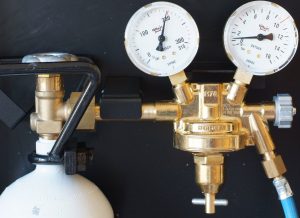2. Thermodynamic Properties of a Pure Substance
2.2 Thermodynamic properties
Pure substances are widely used in thermodynamic cycles. For example, in the vapour-compression refrigeration cycle, Figure 1.4.2, refrigerant R134a is used as the working fluid, which is circulated through a compressor, condenser, expansion valve, and evaporator via the connecting tubes.
In steam power plants, water is used as the working fluid. Figure 2.2.1 shows a coal-fired steam power plant. Purified water flows vertically up the tube-lined walls of the boiler, where it turns into steam. Steam flows into the boiler drum (17), separating from any remaining water, and then flows into the pendant superheater (19), where its temperature and pressure increase rapidly to around 200 bar and 570°C. The superheated steam is piped to the high-pressure turbine (11), where both its pressure and temperature are reduced. The steam is then returned to the boiler reheater (21). After being reheated, it enters the intermediate-pressure turbine (9) and then the low-pressure turbine (6). The steam, now just above its boiling point, is brought into thermal contact with the cold water in the condenser (8), where it is condensed rapidly back into water. The water then passes a feed pump (7), a de-aerator (12), a feed heater (13), and an economizer (23) before being returned to the boiler drum.
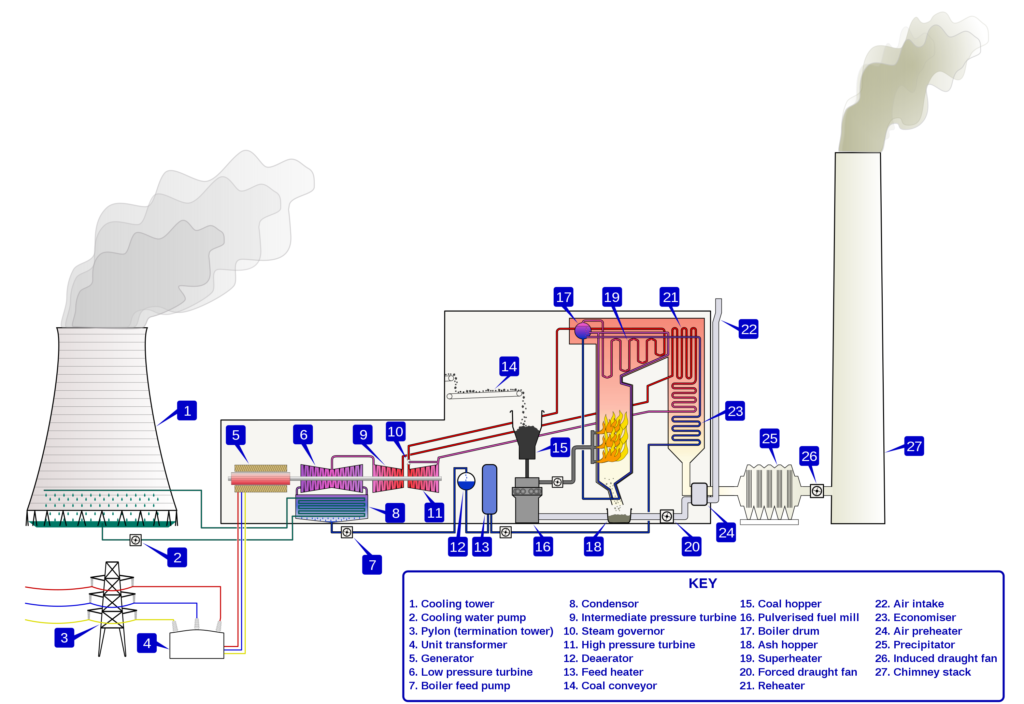
In both cycles, the working fluids, water and R134a, are pure substances. Their properties, such as pressure and temperature, continuously change as they flow through different devices in the cycles. How are the changes of fluid properties related to the overall performance of a device, such as the aforementioned steam power plant and refrigerator? To answer this question, we need to understand the thermodynamic properties of pure substances at different states of a process or a cycle.
The common properties of a pure substance include pressure, temperature, specific volume, density, specific internal energy, specific enthalpy, and specific entropy. These properties are interrelated to each other. Thermodynamic tables or equations of state are commonly used to determine the thermodynamic properties of a pure substance. Appendices A-D provide thermodynamic tables for selected pure substances. The ideal gas equation of state will be introduced in Chapter 3.
2.2.1 Pressure
Consider a normal force exerted by an object on a surface. Pressure is defined as the normal force per unit area of the surface.
where
In the SI units, force is usually expressed in Newtons, N, or kilo Newtons, kN, and area in meter squared, m2; therefore, pressure is expressed in Pascal, 1 Pa = 1 N/m2, or kilo-Pascal, 1 kPa = 1 kN/m2. Other common SI units include 1 bar =100 kPa, 1 atm =101.325 kPa, and 1 MPa = 106 Pa =1000 kPa.
Pressure depends on the normal force and the contact area. If you stand up tall on a flat horizontal surface, the pressure on your feet is your weight divided by the total contact area of your feet on the surface. If you lift up one foot, the pressure on your other foot will double as the contact area is decreased by half.
Pressure in a fluid acts equally in all directions at a given point in that fluid; therefore, pressure is a scalar quantity. It is important to note that although pressure is a scalar quantity, pressure force,
Pressure in a fluid is commonly measured by pressure gauges (Figure 2.2.2) or U-tube manometers (Figure 2.2.3). Most pressure gauges are calibrated to show the gauge pressure or vacuum pressure, which is the difference between the absolute pressure and the atmospheric pressure.
Gauge pressure:
Vacuum pressure:
where
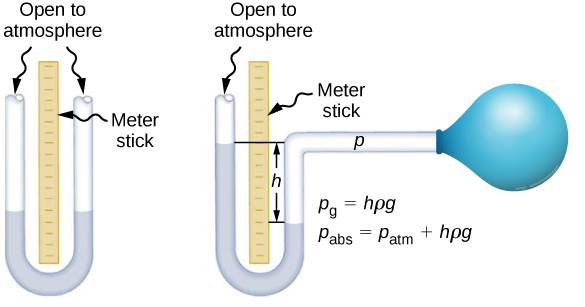
Example 1
Consider a piston-cylinder device containing a gas. The mass of the piston is 10 kg. The diameter of the piston is 20 cm. The atmospheric pressure is 1 atm = 101.325 kPa. What is the absolute pressure of the gas in the cylinder assuming the piston is in static equilibrium? The friction between the piston and the cylinder is negligible.
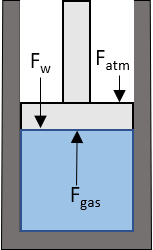
Solution
There are three forces acting on the piston:
- Weight of the piston
- Force due to the atmospheric pressure
- Force due to the gas pressure
As the piston is in static equilibrium, the resultant force on the piston is zero.
Therefore, the absolute pressure of the gas is
The gauge pressure of the gas is
2.2.2 Temperature
Temperature is another measurable thermodynamic property, which indicates the hotness or coldness of a body. Thermometer is a common device for temperature measurement. If two bodies have the same temperature readings on a thermometer, the two bodies must have the same temperature. In other words, they are in thermal equilibrium. This seemingly obvious observation is called the zeroth law of thermodynamics: if two bodies are in thermal equilibrium with a third, the three bodies must be in thermal equilibrium with each other. This law establishes the basis for temperature measurement; it allows us to compare the temperatures of different bodies, no matter if they are in contact or not.
Temperature can be expressed on different temperature scales, such as Celsius or Kelvin scales in the SI units and Fahrenheit or Rankine scales in the Imperial units. For example, a room temperature may be expressed as 20oC or 68 F. All temperature scales are calibrated based on two easily reproducible temperatures, such as the freezing and boiling temperatures of water at the standard atmospheric pressure.
A temperature expressed in Kelvin in the SI units or in Rankine in the Imperial units is called absolute temperature. An absolute temperature of zero indicates the state of the minimum energy of a matter. Absolute temperature, also called thermodynamic temperature, is an important property in thermodynamic analyses. The conversion between the Celsius and Kelvin scales is
2.2.3 Density and specific volume
Density is defined as the mass per unit volume of a body. Specific volume is the reciprocal of density.
where
Both temperature and pressure may affect the density and specific volume of a fluid. The density and specific volume of a gas are strong functions of both temperature and pressure. For example, when a gas is compressed, its pressure will increase, causing the density of the gas to increase and the specific volume of the gas to decrease. When a gas is heated, its temperature will increase. Consequently, the density of the gas will decrease and the specific volume of the gas will increase.
On the contrary, the density and specific volume of a liquid depend much more strongly on the temperature than on the pressure; therefore, it is common to assume that the density and specific volume of a liquid are functions of temperature only.
Example 2
A container consists of two sections separated by a membrane. Section A contains 0.5 kg of air. Its volume is 0.75 m3. Section B contains air of density 0.6 kg/m3. Its volume is 0.5 m3. If the membrane is broken, and the air in the two sections mixes and reaches a uniform state, what is the specific volume of the air at the final state?
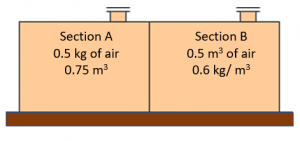
Solution
The masses and volumes in sections A and B at the initial state are
The two sections reach a uniform state at the final state; therefore,
Therefore,
2.2.4 Internal energy and specific internal energy
The essence of the first law of thermodynamics is energy conservation. We need to understand different forms of energy in a system. Internal energy, kinetic energy, and potential energy constitute the total stored energy of a system if the system is free of magnetic, electric, and surface tension effects.
where
Internal energy is associated with the motions and structure of the molecules of a system in a microscopic level. A system, no matter how tiny it is, contains a significantly large number of molecules in various modes of random motions, such as translation, rotation, and vibration. Although it is difficult to predict the behaviour of individual molecules, the statistical average can be calculated by using statistical theory. From a statistical standpoint, the internal energy of a system is considered to be the sum of the kinetic and potential energies of the collection of all molecules in the system. Maxwell explains the relation between the molecular velocity (a microscopic quantity) and the temperature (a macroscopic quantity) of a gas: as the temperature increases, the gas molecules move faster causing the mean microscopic kinetic energy of all molecules to increase; therefore, the internal energy of the system increases. In other words, the internal energy of a substance is strongly associated with the temperature of the substance; therefore, internal energy is a form of thermal energy. For example, the internal energy of 1 kg of water at 500 kPa increases from about 83.88 kJ to 167.47 kJ when its temperature increases from 20oC to 40oC. In general, temperature has a dominant effect on the internal energy of a system although other factors, such as pressure, phase, and chemical composition may also have an effect on the internal energy of a system.
From a macroscopic standpoint, a thermodynamic system, as a whole, has both kinetic and potential energies when it is in motion and is positioned at an elevation on Earth. The kinetic and potential energies are two forms of mechanical energy. They must be described with respect to an external reference frame. When a system experiences a change of elevation or velocity, the kinetic and potential energies of the system will convert between each other. For example, a rock falling from a cliff gains kinetic energy but losses potential energy because its elevation decreases with respect to the ground.
In general, the total stored energy of a thermodynamic system consists of the internal, kinetic, and potential energies. However, the kinetic and potential energies are insignificant compared to the internal energy in many cases, and thus can be neglected.
where
The internal energy and specific internal energy are important properties for the analysis of closed systems, which will be explained in detail in Chapters 4-6.
2.2.5 Enthalpy and specific enthalpy
Enthalpy is an important thermodynamic property for the analysis of open systems or control volumes, where mass transfer is always accompanied by energy transfer. Enthalpy is calculated as the sum of the internal energy,
Now, what is flow work and why is it written as
where
For flow through an open system or control volume, both the internal energy carried by the fluid throughout the flow and the flow work required to maintain the flow contribute to the change of energy in a control volume. Therefore, it is common to combine the internal energy and the flow work as a new thermodynamic property, enthalpy,
Enthalpy, similar to the internal energy, is an extensive property because its value depends on the mass of a system. Its corresponding intensive property is called specific enthalpy, or enthalpy per unit mass of a substance.
where
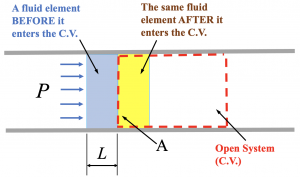
2.2.6 Entropy and specific entropy
Some processes occur spontaneously in nature, such as salt dissolving in water. But some processes cannot occur spontaneously in nature. For example, water at 80oC and 10oC can mix in a container and eventually reach a thermal equilibrium. The mixture, however, cannot separate spontaneously into water at 80oC and water at 10oC. In other words, the process of separating the mixture is “irreversible” and cannot happen spontaneously. We may use a thermodynamic property called entropy to help us understand the physics of such phenomena.
Entropy is a measure of the lack of order resulting from the dispersal of energy and matter. Every spontaneous process is accompanied by an increase in the entropy (or disorder) of the universe. From a statistics point of view, it is more probable that the dispersal of energy and matter in a process is rather “random” than “orderly”. If we consider a fixed amount of gas in an isolated container, as illustrated in Figure 2.2.5. The probability of the molecules having a random distribution is much higher than the probability of them having an “orderly” distribution. Entropy is a concept to represent the degree of the “randomness” or “disorder” of a system. Such “disorder” was explained in statistical theories by early scientists such as Maxwell, Boltzmann, and Gibbs. Nowadays, entropy has been generally recognized as an important thermodynamic property associated with the “quality” aspect of the energy of a system; while energy represents the “quantity” aspect of the energy of the system. Both energy and entropy are of great importance in thermal analysis. The first law of thermodynamics, see Chapters 4 and 5, addresses the concepts of energy and energy conservation. The second law of thermodynamics is closely associated with the concepts of entropy and entropy generation, which explain why a process in nature only occurs in the direction of decreasing the quality of energy or increasing the entropy of the universe. These concepts will be explained in detail as we study the second law of thermodynamics in Chapter 6.
Entropy,
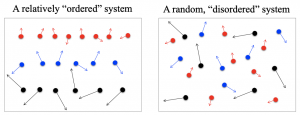
Practice Problems
Practice Problems
Media Attributions
- Steam Power Plant © BillC is licensed under a CC BY-SA (Attribution ShareAlike) license
- Pressure gauge © Nutzdatenbegleiter is licensed under a CC BY-SA (Attribution ShareAlike) license
- U-tube Manometer © OpenStax University Physics is licensed under a CC BY-SA (Attribution ShareAlike) license
Pressure is the normal force exerted by an object on a surface per unit area of the surface.
Absolute pressure is a pressure that is measured relative to an ideal reference, or absolute vacuum. It is the sum of the atmospheric pressure and the gauge pressure. Absolute pressure is ALWAYS a positive number.
Temperature is a measurable thermodynamic property that indicates the hotness or coldness of a body.
Absolute temperature, also called thermodynamic temperature, is the temperature expressed on the Kelvin or Rankine scale. Absolute zero (0 K or 0 R) is the minimum possible temperature. Matter at absolute zero is in the state of lowest possible (minimum) energy.
Density is the mass per unit volume of a body or a system.
Specific volume is the volume per unit mass of a system. It is the reciprocal of density.
Internal energy is a form of thermal energy. From a macroscopic level, it is strongly associated with the temperature of a system. From a microscopic level, it is associated with the motions and structure of the molecules of a system.
Specific internal energy is the internal energy per unit mass of a system.
Enthalpy is a thermodynamic property. It is defined as the sum of the internal energy of a system and the flow work associated with the flowing fluid.
Specific enthalpy is the enthalpy per unit mass of a system.
Entropy is a thermodynamic property, which quantifies the degree of disorder of a system resulting from the dispersal of energy and matter in a process.
Specific entropy is the entropy per unit mass of a system.

